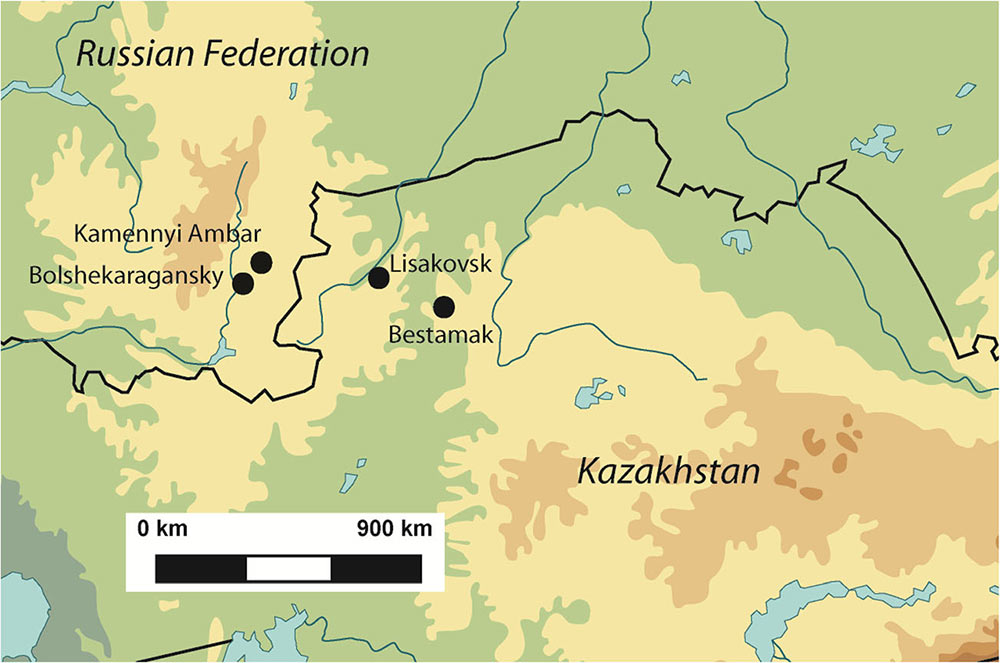Open access Pasture usage by ancient pastoralists in the northern Kazakh steppe informed by carbon and nitrogen isoscapes of contemporary floral biomes, by Miller et al. Archaeol Anthropol Sci (2018).
Interesting excerpts (emphasis mine):
Bronze age settlement, society, and subsistence in the northern Kazakh steppe
The Middle to Late Bronze Age (2200 to 1400 cal BCE) in the northern Kazakh steppe encompassed a major shift in settlement patterns from semi-sedentary pastoralism to more dispersed, mobile lifeways engaged in pastoral nomadism (Tkacheva 1999; Grigory’ev 2002; Koryakova and Epimakhov 2007; Kuz’mina 2007; Tkacheva and Tkachev 2008). Middle Bronze Age (2200 to 1700 cal BCE) settlements had large enclosures consisting of an earthen wall and ditch. Inside the enclosure, earthen domestic structures with shared walls (numbering from 30 to 60) housed an estimated 200 to 700 individuals (Gening et al. 1992; Grigor’yev 2002; Anthony 2007; Kohl 2007; Koryakova and Epimakhov 2007; Hanks 2009; Batanina and Hanks 2013). MBA settlements were repeatedly occupied, evidenced by successive building phases that added structures and enlarged enclosures. Aggregated MBA sites are situated between 40 and 60 km apart, and landscapes between enclosed settlements may have been territories of particular settlements (Epimakhov 2002; Zdanovich and Batanina 2002; Merrony et al. 2009; Stobbe et al. 2016). While there is currently no archeological evidence for structures such as animal corrals or walls outside of MBA settlement enclosures, open areas within settlements may have been used to house livestock. Reconstructions of landscape use in the vicinity of MBA sites determined that pastures within 4 km of the site could have supported herd sizes large enough to sustain sedentary livestock herders (Stobbe et al. 2016). During the subsequent Late Bronze Age (1800 to 1400 cal BCE) settlements were more dispersed across the landscape and significantly smaller, consisting of fewer than 20 dwellings, further lacking enclosures and building phases (Kuz’mina 2007:36–8; Zakh and Ilyushina 2010). This shift in settlement size and distribution has been interpreted to indicate the emergence of nomadic pastoralism and the intensification of long-distance mobility (Tkacheva 1999; Grigory’ev 2000; Kuz’mina 2007; Tkacheva and Tkachev 2008).
MBA communities engaged in pastoralism and supplemented their diets with wild plants and wild game (Krause and Koryakova 2013; Ventresca Miller et al. 2014a; Hanks et al. 2018). A variety of wild plants have been recovered during flotation, but so far, domesticated grains have not been recovered (Krause and Koryakova 2013; Ng 2013; Hanks et al. 2018). Carbon and nitrogen stable isotope analyses of bone collagen indicate that human dietary intake in the MBA focused on terrestrial animal protein, likely in the form of meat and milk, which was supplemented by locally available fish and wild plants (Ventresca Miller et al. 2014a; Hanks et al. 2018). While the subsequent LBA has been interpreted as a shift to nomadic pastoralism, little data is available regarding landscape use or herd management strategies for this period. Paleodietary studies suggest that human diets during the LBA focused on pastoral products and were supplemented by wild plants, fish, and wild animals (Ventresca Miller et al. 2014a, 2014b).

Conclusions
A major shift in patterns of settlement occurred at the Middle to Late Bronze Age transition, from large semi-sedentary populations in enclosed settlements to smaller populations in open settlements dispersed across the landscape. Scholars have suggested that animal management strategies also changed at this time from semi-sedentary pastoralism to more mobile forms of pastoral nomadism. However, our findings suggest that livestock management practices did not shift in concert with social landscapes, demonstrating consistency in pastoral adaptations through time in the region. Similar isotopic patterning between livestock during the MBA and LBA across several sites in the CES indicates that there were no changes across time in pasture usage patterns. Among ancient livestock, differences in δ13C and δ15N values between horses and ruminants (cattle, sheep, goat) strongly suggest that livestock were grazed pastures either extensively or intensively, respectively. Horses grazed in open steppe areas or intermittently in areas with well-watered soils that lacked salinity, likely staying well outside of settlements. In contrast, cattle and sheep/goat grazed in pastures across multiple zones, both near the settlement and in non-local pastures that were grazed intensively. A wider range of δ13C and δ15N values among ruminants at Kamennyi Ambar (MBA) suggests that aggregated human populations may have had larger herds, some of which accessed non-local pastures outside of the easily accessible territories surrounding enclosed sites. Continued research on the isotopic composition of vegetation surrounding Bronze Age sites should clarify patterns of landscape use between MBA sites.
Related:
- Sintashta-Petrovka and Potapovka cultures, and the cause of the Steppe EMBA – MLBA differences
- Consequences of Damgaard et al. 2018 (III): Proto-Finno-Ugric & Proto-Indo-Iranian in the North Caspian region
- Eurasian steppe dominated by Iranian peoples, Indo-Iranian expanded from East Yamna
- No large-scale steppe migration into Anatolia; early Yamna migrations and MLBA brought LPIE dialects in Asia
- Early Indo-Iranian formed mainly by R1b-Z2103 and R1a-Z93, Corded Ware out of Late PIE-speaking migrations
- Y-DNA haplogroup R1b-Z2103 in Proto-Indo-Iranians?
- North Pontic steppe Eneolithic cultures, and an alternative Indo-Slavonic model
- The concept of “Outlier” in Human Ancestry (III): Late Neolithic samples from the Baltic region and origins of the Corded Ware culture
- New Ukraine Eneolithic sample from late Sredni Stog, near homeland of the Corded Ware culture
- The renewed ‘Kurgan model’ of Kristian Kristiansen and the Danish school: “The Indo-European Corded Ware Theory”
Join the discussion...
It is good practice to be registered and logged in to comment.Please keep the discussion of this post on topic.
Civilized discussion. Academic tone.
For other topics, use the forums instead.